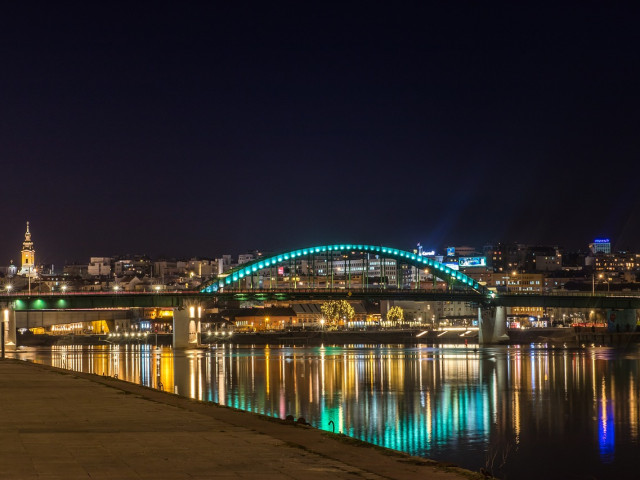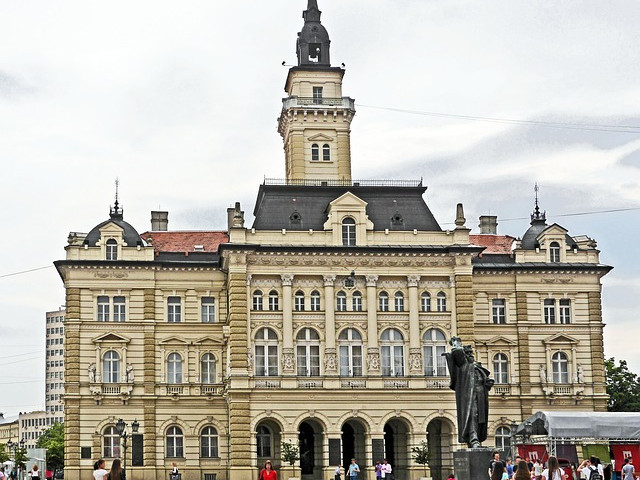
| Capital | Belgrade |
| Currency | Dinar |
| Languages | Serbian |
| Government | Republic |
| Timezone | GMT + 1 |
| Population | 7.5 million (excluding Kosovo: 2.4 million) |
| Dialing code | (00) 381 |
After years of war, Serbia is beginning to re-emerge as a tourist destination and it is rapidly becoming one of Europe's most popular 'undiscovered' spots.
Particularly in the capital Belgrade, you’ll find museums, galleries, and world-class opera and theatre productions. The city's club scene is new and exciting. Novi Sad, known as the 'Serbian Athens', is situated along the banks of the Danube and play host to 'Exit', southeast Europe's largest music festival.
Aside from its many beautiful towns and cities, Serbia offers stunning vineyards, majestic gorges and huge national parks.
Particularly in the capital Belgrade, you’ll find museums, galleries, and world-class opera and theatre productions. The city's club scene is new and exciting. Novi Sad, known as the 'Serbian Athens', is situated along the banks of the Danube and play host to 'Exit', southeast Europe's largest music festival.
Aside from its many beautiful towns and cities, Serbia offers stunning vineyards, majestic gorges and huge national parks.
Where to buy tickets for Serbia
The Trainline
Booking Platform
The Trainline is a British digital rail and coach technology platform operating across Europe.
Visit The TrainlineSponsored Link
Omio
Booking Platform
Omio is a German online travel comparison and booking website based in Berlin.
Visit OmioSponsored Link
What to expect from the weather in Serbia
Serbia is characterized by a continental climate (cold winters and hot, humid summers with well distributed rainfall). In central Serbia, the climate is continental or Mediterranean; in the south, an Adriatic climate is predominant; with hot, dry summers and autumns and relatively cold winters with heavy snowfall. Inland, the average temperature in summer ranges from 18 to 19 degrees Celsius; in the coastal areas it ranges pleasantly from 23 to 26degrees Celsius. In winter, temperatures do not fall to any extremes and range from 2 to 3 degrees Celsius on average.
Accommodation
Deluxe/A-class hotels can only be found in Belgrade whilst by contrast smaller towns are thought to have rather poor hotel facilities and services. Advance booking is essential.
Different types of private rooms and B&B accommodation are available throughout the country; there also are motels near most main roads. Prices depend on the region, whether it’s the main tourist season and of course, the type of hotel.
Many people offer rooms, often with meals included in the prices, to visitors in villages. Off season discounts are available and prices are negotiable. Local tourist offices or travel agencies will be able to provide you with details.
Camping/Caravanning is only available on official sites in Serbia. For off-site camping, you need a permit from the local tourist office. A list is available from the National Tourism Organisation.
Alpine Club huts are available in most mountain areas and provide another option to visitors. In addition you may consider hostels while in Serbia and these are located in bigger cities. The National Tourism Organisation of Serbia (NTOS) or the Serbia Youth Hostel Association can do the bookings for you.
Different types of private rooms and B&B accommodation are available throughout the country; there also are motels near most main roads. Prices depend on the region, whether it’s the main tourist season and of course, the type of hotel.
Many people offer rooms, often with meals included in the prices, to visitors in villages. Off season discounts are available and prices are negotiable. Local tourist offices or travel agencies will be able to provide you with details.
Camping/Caravanning is only available on official sites in Serbia. For off-site camping, you need a permit from the local tourist office. A list is available from the National Tourism Organisation.
Alpine Club huts are available in most mountain areas and provide another option to visitors. In addition you may consider hostels while in Serbia and these are located in bigger cities. The National Tourism Organisation of Serbia (NTOS) or the Serbia Youth Hostel Association can do the bookings for you.
What are the business hours?
Banks are open Mondays - Fridays 09:00-19.00 and on Saturdays 08:00-15:00. Banks are open by rotations on Sundays. Shops are typically open Mondays - Fridays 08:00-19:00 and 08:00-15:00 on Saturdays.
What about travel visas?
For stays up to 90 days citizens of the following countries do not require a visa: Germany, France, Italy, the Netherlands, Belgium, Luxembourg, Great Britain, Ireland, Spain, Portugal, Greece, Denmark, Sweden, Finland, Austria, Switzerland, Norway, Iceland, Monaco, Liechtenstein, Vatican, Andorra, San Marino, Israel, Cyprus, Malta, the Czech Republic, Slovakia, Poland, Slovenia, Lithuania, Latvia, Estonia, Croatia, the United States of America, Canada, Singapore, the Republic of Korea, Australia and New Zealand.
How much should you tip in Serbia?
Tipping is not considered obligatory in restaurants, however where you are happy with the service you receive then a tip in the region of 10 to 15% would be considered appropriate.
In bars or when paying for a taxi ride a tip is given through you rounding up the price e.g. 33.50 may be rounded to 35 when paying. You would simply pay the rounded amount and say 'that's correct' when handing over or say 'make it 35' when change is required.
In bars or when paying for a taxi ride a tip is given through you rounding up the price e.g. 33.50 may be rounded to 35 when paying. You would simply pay the rounded amount and say 'that's correct' when handing over or say 'make it 35' when change is required.
| ATM availability | Available |
| Emergency services | Ambulance 94, police 92, fire 93 |
| Tourist board | http://www.serbia-tourism.org |
| Famous for | Ana Ivanovi? (Tennis Player) |
| Useful phrases | Zdravo (hello), dovioenja (goodbye), hvala (thank you) |
History
It was Austria's declaration of war on Serbia in 1914 which marked the beginning of WW1. After winning several battles, Serbian troops were eventually driven out of much of the Serb territories by Austrian, German and Bulgarian forces. By the end of the war 58% of Serbia's male population had been lost creating immense social issues which have taken a great deal of time for it to recover from.
The fall of the Austro-Hungarian and Ottoman Empires after WW1 provided the opportunity for the Kingdom of Serbs, Croats and Slovenes to be proclaimed in December 1918. A political crises in 1928 led to the King Alexander I taking advantage and assuming power. He banned political parties and took the step of renaming the country Yugoslavia.
Yugoslavia was invaded in WW2 and divided between Germany, Hungary, Italy and Bulgaria. Communist partisan leader Tito, who led the successful resistance movement, became leader of the federal republic of Yugoslavia in 1945. While Serbia became a republic, Kosovo and Vojvodina were denied that status. In 1986, there was a war for a ’Greater Serbia’ under communist leader Milosevic. Serbia and Montenegro formed a third Yugoslav federation that held no independence for Kosovar Albanians – in 1998, violence erupted in Kosovo.
In 1999, Serbia began to ‘get rid’ of its Albanians with hundreds of thousands taking refuge in Macedonia and forcing NATO to take action; Kosovo became a UN/NATO protectorate and the Serbian forces withdrew. In the federal presidential elections of 2001 Milosevic was defeated.
Yugoslavia rejoined the UN. Later that year, Milosevic was arrested and put before the war crimes tribunal in The Hague, he died in 2006.
The Yugoslav federation was replaced by a loose union of Serbia and Montenegro in 2002; in 2006, the remainder of Yugoslavia was dissolved by the Montenegrins’ voting for independence.
The fall of the Austro-Hungarian and Ottoman Empires after WW1 provided the opportunity for the Kingdom of Serbs, Croats and Slovenes to be proclaimed in December 1918. A political crises in 1928 led to the King Alexander I taking advantage and assuming power. He banned political parties and took the step of renaming the country Yugoslavia.
Yugoslavia was invaded in WW2 and divided between Germany, Hungary, Italy and Bulgaria. Communist partisan leader Tito, who led the successful resistance movement, became leader of the federal republic of Yugoslavia in 1945. While Serbia became a republic, Kosovo and Vojvodina were denied that status. In 1986, there was a war for a ’Greater Serbia’ under communist leader Milosevic. Serbia and Montenegro formed a third Yugoslav federation that held no independence for Kosovar Albanians – in 1998, violence erupted in Kosovo.
In 1999, Serbia began to ‘get rid’ of its Albanians with hundreds of thousands taking refuge in Macedonia and forcing NATO to take action; Kosovo became a UN/NATO protectorate and the Serbian forces withdrew. In the federal presidential elections of 2001 Milosevic was defeated.
Yugoslavia rejoined the UN. Later that year, Milosevic was arrested and put before the war crimes tribunal in The Hague, he died in 2006.
The Yugoslav federation was replaced by a loose union of Serbia and Montenegro in 2002; in 2006, the remainder of Yugoslavia was dissolved by the Montenegrins’ voting for independence.
Politics
Serbia has a multi-party system in which there are so many parties that no one alone has a chance of gaining power and therefore they must work together to form coalition governments. Currently, Serbia has got 342 political parties. The National Assembly of Serbia has 250 elected representatives and is elected every 4 years.
Amongst others, Serbia’s main political parties include: Serbian Radical Party (SRS), Democratic Party of Serbia (DSS), Democratic Party (DS), Serbian Renewal Movement (SPO), New Serbia (NS) coalition (the only declared advocate of the monarchy) and G17 Plus (they fight for for economic reforms, a better quality of life, and membership of the European Union).
Executive power in Serbia lies with the government, legislative power with the government and the National Assembly and judicial power with the independent judiciary.
Amongst others, Serbia’s main political parties include: Serbian Radical Party (SRS), Democratic Party of Serbia (DSS), Democratic Party (DS), Serbian Renewal Movement (SPO), New Serbia (NS) coalition (the only declared advocate of the monarchy) and G17 Plus (they fight for for economic reforms, a better quality of life, and membership of the European Union).
Executive power in Serbia lies with the government, legislative power with the government and the National Assembly and judicial power with the independent judiciary.
Geography
Serbia is located in south eastern Europe, bordering the Adriatic Sea, between Albania and Bosnia and Herzegovina. It covers a total area of 102,000 sq km, of which all but 200 sq km is land mass, he remainder being water. It has 2,246 km of land borders that it shares with Albania, Bosnia and Herzegovina, Bulgaria, Croatia, Hungary, Macedonia and Romania. 200km of Serbia’s borders are coastline.
Economy
For Serbia’s economy, it is the service and agricultural sectors that are particularly important. UN economic sanctions in place between 1992-1995, and the damage to the country's infrastructure and industry during the NATO airstrikes in 1999 damaged Serbia’s economy. It further suffered as a consequence of it losing the markets it had previously served in the former Yugoslavia and the SEV.
Many economic problems remain such as the high unemployment rate, high export deficit and large public debt, however prospects are generally now thought to be good for the country.
After 2000, the country experienced a certain degree of economic growth. Preparation for membership of the European Union has forced economic reforms which have had a positive impage, whilst the EU is now also Serbia's most important trading partner.
Many economic problems remain such as the high unemployment rate, high export deficit and large public debt, however prospects are generally now thought to be good for the country.
After 2000, the country experienced a certain degree of economic growth. Preparation for membership of the European Union has forced economic reforms which have had a positive impage, whilst the EU is now also Serbia's most important trading partner.



